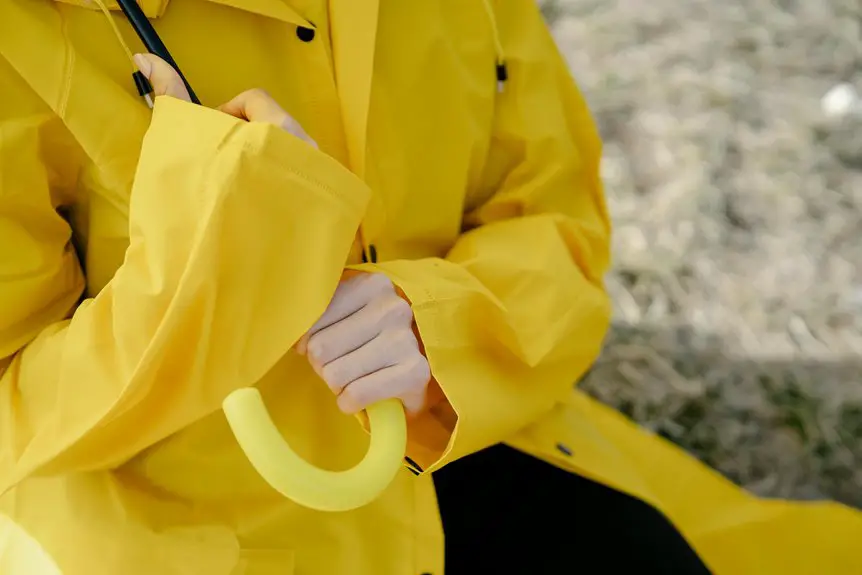When you layer moisture-wicking clothing properly, you can stay comfortable no matter the weather. It’s not just about piling on clothes but choosing pieces that work together to manage sweat and temperature. Understanding how each layer functions can change how you handle cold mornings and unexpected rain. But what exactly makes these fabrics so effective, and how do you build a system that adapts to different conditions?
Table of Contents
Key Takeaways
- Moisture-wicking baselayers pull sweat away from skin, keeping you dry and comfortable in all weather conditions.
- Combine a moisture-wicking baselayer with an insulating mid-layer for warmth and effective moisture management.
- Use breathable, wind-resistant outer layers to protect against elements while allowing moisture to escape.
- Select fabrics like polyester or merino wool for efficient sweat management and temperature regulation.
- Tailor layering strategies to specific activities and weather for optimal comfort and performance.
Understanding Moisture-Wicking Fabrics and Their Benefits
Although you mightn’t notice it immediately, moisture-wicking fabrics play an essential role in keeping you comfortable during physical activities.
These fabric types, often made from synthetic fibers like polyester or nylon, actively pull sweat away from your skin to the fabric’s surface. This sweat management prevents moisture buildup, reducing discomfort and chafing.
Unlike cotton, which soaks up sweat and stays damp, moisture-wicking materials dry quickly, helping regulate your body temperature.
When you choose the right fabric types, you’ll stay drier and cooler, enhancing your performance and comfort.
Understanding how these fabrics work empowers you to pick clothing that handles sweat effectively, so you can focus on your activity without distraction or irritation.
The Role of Baselayers in Temperature and Moisture Control
When you wear a baselayer, it serves as your first line of defense in regulating both temperature and moisture. The baselayer benefits you by drawing sweat away from your skin, keeping you dry and comfortable. It adapts to your body heat, ensuring effective temperature regulation whether you’re active or resting. Choosing the right baselayer material is key to maximizing these benefits.
| Baselayer Material | Moisture Control | Temperature Regulation |
|---|---|---|
| Merino Wool | Excellent | Warm in cold, cool in heat |
| Synthetic (Polyester) | Very Good | Quick drying, moderate insulation |
| Silk | Good | Lightweight, moderate warmth |
| Cotton | Poor | Retains moisture, poor insulation |
| Bamboo | Good | Breathable, moisture-wicking |
Use your baselayer to maintain comfort by balancing moisture and temperature effectively.
Building an Effective Thermal Layering System
Since your baselayer manages moisture and temperature at the skin level, building an effective thermal layering system means adding layers that trap heat without sacrificing breathability.
Start with a mid-layer that provides thermal insulation while allowing moisture to escape. Fleece or lightweight wool work well here.
Next, use outer layers designed for protection against wind and rain but that still breathe.
When layering, apply proven layering techniques: combine materials that complement each other’s properties to maximize warmth and comfort.
Avoid bulky layers that restrict movement or trap sweat.
By carefully selecting and arranging your layers, you create a system that adapts to changing conditions, keeps you warm, and prevents overheating.
Mastering these layering techniques guarantees you stay comfortable in all weather.
Adapting Layering Strategies for Different Activities
Understanding how to build a solid thermal layering system sets a strong foundation, but you’ll need to adjust your approach depending on the activity you’re doing.
For hiking adaptations, prioritize breathability and flexibility—choose moisture-wicking base layers that handle sweat efficiently and insulating mid-layers that don’t restrict movement. Add or remove layers easily as terrain and weather fluctuate.
When it comes to cycling strategies, focus on streamlined, aerodynamic layers that reduce bulk and prevent overheating. Opt for moisture-wicking fabrics that dry quickly and wind-resistant outer layers to combat speed chill.
Keep in mind, layering for cycling often means thinner, more fitted pieces compared to hiking. Tailoring your layering system this way guarantees you stay comfortable and dry, no matter the activity or changing conditions.
Innovations in Moisture-Wicking Technology and Materials
Advancements in moisture-wicking technology have transformed how you stay dry and comfortable during physical activities.
Today’s smart textiles actively manage sweat by drawing moisture away from your skin and speeding up evaporation, keeping you cooler and drier. These fabrics often incorporate nano-coatings or embedded sensors that adapt to changing temperatures and activity levels, enhancing your comfort throughout the day.
Additionally, the rise of sustainable materials means you don’t have to sacrifice eco-consciousness for performance. Many moisture-wicking garments now use recycled fibers or biodegradable fabrics, reducing environmental impact while maintaining high functionality.
When you choose innovative moisture-wicking layers, you’re not just improving your comfort—you’re embracing smarter, greener gear that performs well in any weather condition.
Frequently Asked Questions
How Do I Properly Care for and Wash Moisture-Wicking Clothing?
You should follow fabric care instructions carefully. Use cold water and gentle detergent, avoid fabric softeners, and wash moisture-wicking clothing inside out. These washing tips help maintain its performance and extend your gear’s lifespan.
Can Moisture-Wicking Fabrics Cause Skin Irritation or Allergies?
You might experience skin sensitivities or allergies from certain moisture-wicking fabric types, especially synthetic ones. If that happens, try switching to natural or hypoallergenic materials, and always test new fabrics on a small skin area first.
Are Moisture-Wicking Clothes Effective in Humid Conditions?
You’ll find moisture-wicking clothes effective even in high humidity because they reduce moisture retention on your skin. The humidity impact is lessened as these fabrics pull sweat away, keeping you cooler and more comfortable all day.
What Are the Environmental Impacts of Moisture-Wicking Fabric Production?
While moisture-wicking fabrics boost performance, their production often harms the environment. You can choose brands embracing sustainability practices and fabric alternatives like bamboo or recycled polyester to reduce ecological impact without sacrificing comfort or function.
How Do Moisture-Wicking Clothes Perform During Extended Wear Without Washing?
You’ll find moisture-wicking clothes manage odor well during extended wear, keeping you fresher longer. Plus, their fabric longevity means they hold up without frequent washing, maintaining performance and comfort over time.
- The History of Abaca Fiber: The Pride of the Philippines - June 25, 2025
- Abaca Fiber Characteristics: What Makes This Natural Fiber So Unique? - June 25, 2025
- A Beginner’s Introduction to the Abaca Fiber Industry - June 25, 2025







